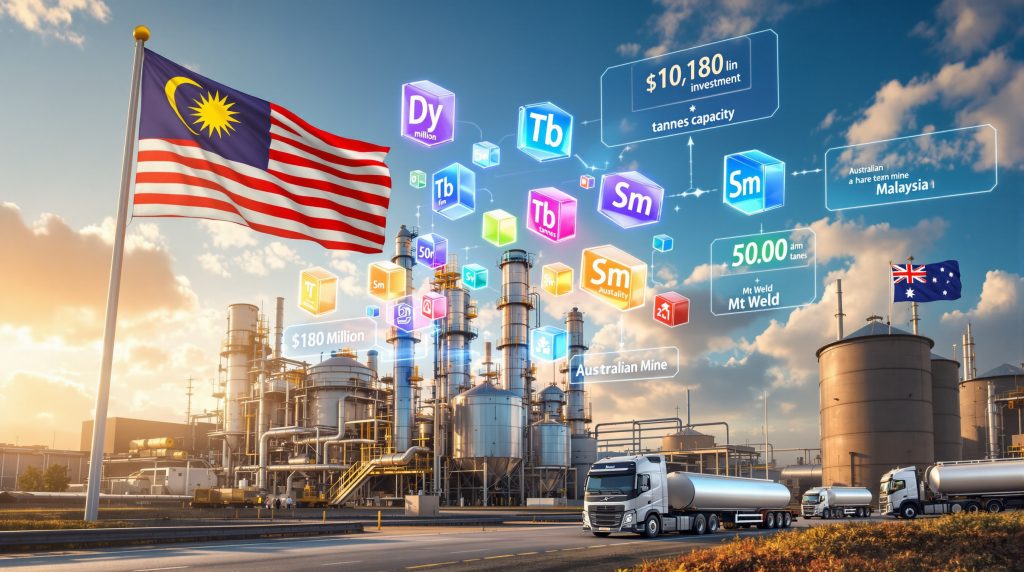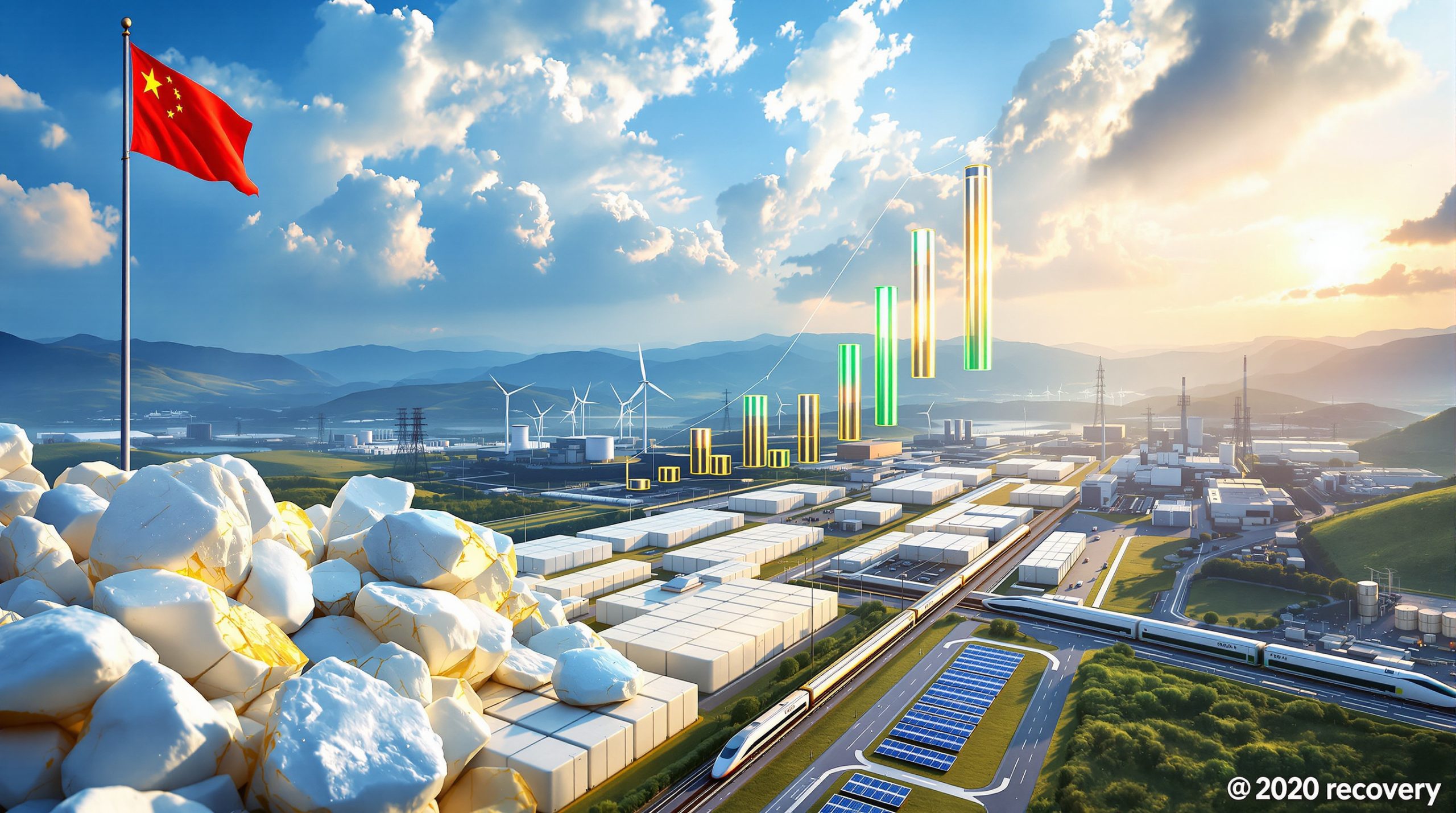Malaysia has emerged as a critical node in the global rare earth supply network, positioning itself as a primary processing hub outside Chinese influence. The Lynas expansion in Malaysia represents a fundamental shift in global supply chain dynamics, addressing critical supply security concerns for Western defense industries and technology manufacturers. Furthermore, this development aligns with broader trends in critical minerals energy security initiatives worldwide. The country's established industrial infrastructure, combined with supportive government policies, creates an environment conducive to large-scale rare earth operations.
The Kuantan facility currently handles light rare earth elements from Australia's Mt Weld mine, one of the world's richest monazite ore bodies. This existing operation provides the technical foundation and operational expertise necessary for expanding into heavy rare earth processing. Consequently, the facility's track record of managing complex chemical separation processes positions Malaysia uniquely for this technological advancement.
Regulatory Framework Supporting Critical Mineral Development
Malaysia's government has implemented policies that encourage foreign investment in critical mineral processing, creating stability for international companies seeking alternatives to Chinese supply chains. These regulatory frameworks address both environmental compliance and strategic resource development, balancing economic growth with environmental protection.
The Malaysian Industrial Development Authority has streamlined approval processes for strategic mineral investments, recognizing the geopolitical importance of rare earth processing capabilities. This regulatory support extends to environmental permitting, though companies must meet stringent standards for waste management and emissions control.
Infrastructure Advantages for Heavy Rare Earth Processing
The existing industrial infrastructure in Kuantan provides essential utilities, transportation networks, and technical expertise necessary for heavy rare earth separation operations. Port facilities enable efficient import of raw materials and export of processed products, while established chemical processing infrastructure reduces capital requirements for facility expansion.
Malaysia's skilled workforce in chemical processing and industrial operations provides human capital advantages over greenfield locations. The country's educational institutions have developed expertise in mineral processing technologies, creating a local talent pool for sophisticated rare earth operations.
Breaking China's Heavy Rare Earth Monopoly
The Lynas expansion in Malaysia represents a fundamental shift in global supply chain dynamics. By establishing heavy rare earth processing capabilities outside China, this project addresses critical supply security concerns for Western defense industries and technology manufacturers. In addition, this development could end decades of Chinese dominance in heavy rare earth production, which is crucial when considering the broader rare earth reserves analysis and global distribution patterns.
| Strategic Impact | Details |
|---|---|
| Supply Diversification | First major non-Chinese heavy rare earth facility |
| Production Capacity | 5,000 tonnes annual heavy rare earth oxide output |
| Timeline to Market | Initial production by April 2026 |
| Investment Scale | $180 million facility expansion |
The facility will produce dysprosium, terbium, and samarium, elements essential for advanced military systems, electric vehicle motors, and high-performance electronics. These materials cannot be easily substituted with alternative elements, making secure supply sources critical for national security and economic competitiveness.
Critical Elements for Defense and Technology Applications
Dysprosium enhances the performance of permanent magnets in high-temperature environments, making it indispensable for military aircraft engines and advanced weapons systems. Terbium provides unique optical properties essential for precision-guided munitions and advanced radar systems.
Samarium-cobalt magnets offer exceptional temperature stability and corrosion resistance, crucial for aerospace applications and deep-sea military equipment. These specialized applications command premium prices and require consistent, high-purity supply sources.
Market Positioning Beyond Chinese Competition
This development creates significant competitive advantages by establishing integrated production capabilities outside Chinese control. While other projects like Energy Fuels in the United States and REEtec in Norway are developing rare earth processing, none match the scale and integration of the Malaysian expansion.
The facility's ability to process both light and heavy rare earths provides operational flexibility and cost advantages through shared infrastructure and expertise. This integration enables economies of scale that smaller, specialised operations cannot achieve.
Technical Specifications of the New Processing Facility
The expanded facility incorporates advanced separation technologies specifically designed for heavy rare earth processing, which requires significantly more complex purification processes than light rare earth elements. Heavy rare earth separation involves multiple stages of solvent extraction and ion exchange to achieve the ultra-high purity levels required for defense and aerospace applications.
The processing methodology builds upon existing infrastructure while adding specialised equipment for heavy rare earth purification. This approach reduces capital costs compared to greenfield developments while leveraging proven operational expertise.
Processing Technology and Methodology
Heavy rare earth separation demands sophisticated chemical processes capable of achieving purity levels exceeding 99.99% for critical applications. The separation process involves cascading solvent extraction systems that selectively separate individual rare earth elements based on subtle differences in chemical properties.
The technology requires precise control of pH levels, temperature, and chemical concentrations throughout multiple processing stages. This complexity explains why few facilities worldwide have successfully commercialised heavy rare earth separation at scale.
Integration with Existing Mt Weld Operations
The Malaysian facility processes feedstock from Australia's Mt Weld mine, creating a geographically distributed but operationally unified supply chain. This integration reduces single-point-of-failure risks while maintaining operational control over the entire value chain from mining through final product delivery.
"The integration of Australian mining with Malaysian processing creates a supply chain structure that reduces geographic concentration risks while maintaining operational efficiency and quality control."
Mt Weld's ore composition provides both light and heavy rare earth content, enabling the Malaysian facility to optimise production based on market demand and pricing conditions. This flexibility provides competitive advantages in volatile commodity markets.
U.S.-Australia Strategic Cooperation in Critical Minerals
This expansion aligns with broader strategic cooperation between the United States and Australia in critical minerals development. The collaboration reflects recognition that rare earth supply security requires coordinated investment and policy support from allied nations. However, this cooperation extends beyond bilateral agreements and forms part of the broader global mining landscape that is rapidly evolving.
Recent agreements between the two nations emphasise building resilient supply chains for materials essential to defence and clean energy technologies. These partnerships combine Australian mineral resources with U.S. market access and technology sharing.
Defense Supply Chain Security
Heavy rare earths are essential components in advanced weapons systems, radar technologies, and military communications equipment. Secure supply sources have become a national security priority as military systems increasingly depend on advanced materials with limited alternative suppliers.
Defence contractors require consistent, high-quality supply sources with established security clearances and quality certifications. The Malaysian facility's alignment with Western defence requirements positions it advantageously for long-term defence contracts.
Economic Diplomacy Through Resource Development
The project represents economic statecraft in action, using private sector investment to achieve broader geopolitical objectives related to supply chain resilience. This approach leverages market mechanisms while addressing strategic vulnerabilities in critical material supplies.
Government support for the project includes policy frameworks, financing assistance, and diplomatic coordination to ensure project success. This multi-faceted support demonstrates the strategic importance of rare earth supply diversification.
Industries Benefiting from Increased Heavy Rare Earth Supply
The automotive industry's transition to electric vehicles creates enormous demand for permanent magnets containing dysprosium and terbium. These elements significantly improve motor efficiency and performance in extreme temperatures, making them essential for high-performance electric vehicle applications.
Electric vehicle manufacturers increasingly specify rare earth-based permanent magnet motors for their superior power density and efficiency characteristics. This trend drives sustained demand growth for heavy rare earth elements beyond traditional defence applications.
Aerospace and Defense Applications
Military aircraft systems require materials capable of performing reliably in extreme environments with zero tolerance for failure. Heavy rare earth elements provide unique magnetic and electronic properties that cannot be replicated with alternative materials.
Missile guidance systems depend on precision sensors and actuators that utilise rare earth-based components for their exceptional performance characteristics. These applications represent high-value, long-term demand sources for heavy rare earth producers.
Renewable Energy Infrastructure
Wind turbine generators increasingly utilise permanent magnet designs that require dysprosium and terbium for optimal performance. These magnets enable direct-drive generators that eliminate gearboxes, reducing maintenance costs and improving reliability.
Advanced energy storage systems also utilise rare earth elements in specialised applications where performance requirements justify premium material costs. Grid-scale storage deployment drives additional demand for these critical materials.
Environmental and Regulatory Compliance Risks
Rare earth processing involves complex chemical procedures that must meet stringent environmental standards, particularly in Malaysia where regulatory oversight has intensified. Environmental compliance represents a significant operational risk that could impact project timelines and costs.
The processing facility must manage radioactive waste materials generated during heavy rare earth separation. These materials require specialised handling procedures and long-term disposal solutions that add complexity and cost to operations. Notably, Lynas has announced its commitment to meeting all regulatory requirements for this expansion.
Permitting and Approval Timelines
Environmental impact assessments and regulatory approvals could extend project timelines beyond current projections. Malaysian authorities have increased scrutiny of industrial projects following previous environmental incidents in the region.
The approval process involves multiple government agencies and requires comprehensive environmental monitoring plans. Delays in this process could impact the April 2026 production timeline and increase project costs.
Waste Management and Processing Byproducts
Heavy rare earth separation generates radioactive waste materials containing thorium and other naturally occurring radioactive elements. These materials require specialised containment and disposal procedures that must comply with international radiation safety standards.
Long-term waste storage and monitoring add ongoing operational costs and regulatory compliance requirements. The facility must demonstrate adequate waste management capabilities throughout its operational lifetime.
Global Competition in Alternative Supply Development
Several projects worldwide are developing rare earth processing capabilities outside China, though none match the scale and integration of the Malaysian expansion. Understanding this competitive landscape provides context for the strategic significance of the Lynas project.
| Project/Company | Location | Focus | Production Timeline |
|---|---|---|---|
| Energy Fuels | United States | Mixed rare earth processing | 2025-2026 |
| REEtec | Norway | Separation technology | Development phase |
| Lynas Malaysia | Malaysia | Heavy rare earth oxides | April 2026 |
Competitive Advantages in Scale and Integration
Unlike smaller development projects, this expansion leverages existing operational infrastructure and proven processing expertise. This approach reduces execution risk compared to greenfield developments while providing cost advantages through shared facilities and expertise.
The facility's scale enables selective pricing strategies and long-term strategic partnerships rather than dependence on volatile spot markets. This positioning provides revenue stability and customer relationship advantages over smaller competitors.
Market Positioning for Long-term Contracts
The facility's capacity and integration enable it to serve as a strategic supplier for major industrial customers requiring consistent, high-quality supply sources. Defence contractors and major automotive manufacturers prefer established suppliers with proven capabilities.
Long-term contract relationships provide revenue predictability while enabling customers to secure critical material supplies. This approach benefits both producers and consumers through reduced price volatility and supply security.
Funding Structure and Financial Strategy
The $750 million equity raise that funds this expansion demonstrates strong investor confidence in rare earth market fundamentals and project execution capabilities. This financing provides adequate capital for facility construction and working capital requirements during the production ramp-up period. Furthermore, this investment reflects broader trends in Australian mining investments that are reshaping the sector.
The funding structure avoids excessive debt leverage that could create financial stress during commodity price volatility. Equity financing provides operational flexibility while aligning investor interests with long-term project success.
Revenue Diversification Through Product Mix
Heavy rare earth elements command significantly higher prices than light rare earths, potentially improving profit margins and reducing volume dependence. This product mix diversification provides revenue stability during market fluctuations.
The ability to adjust production between light and heavy rare earths based on market conditions provides operational flexibility. This adaptability enables optimisation of revenue and margins in response to changing market dynamics.
Strategic Contract Opportunities
Government and defence contractor relationships could provide stable, premium-priced offtake agreements that justify the substantial capital investment. These contracts typically include long-term price protection and volume commitments.
Strategic partnerships with major industrial customers provide market access while reducing marketing and distribution costs. These relationships create competitive advantages through customer loyalty and technical collaboration.
Production Timeline and Market Entry Strategy
Initial samarium production beginning in April 2026 will mark the first commercial heavy rare earth output from the facility. Full-scale operations are expected within 24 months, allowing for operational optimisation and market development.
The phased approach to capacity ramp-up enables quality control optimisation while gradually increasing market supply. This strategy reduces operational risks while demonstrating production capabilities to potential customers.
Phased Capacity Ramp-up
The two-year timeline to full capacity allows for equipment optimisation and process refinement while building customer relationships. This approach reduces technical risks associated with scaling complex chemical processes.
Gradual capacity increases enable market absorption of additional supply without causing price disruption. This measured approach supports stable pricing while building sustainable market share.
Supply Chain Integration Timeline
End-user industries require 12-18 months to qualify new supply sources and integrate them into existing manufacturing processes. This qualification period suggests meaningful market impact will emerge by 2027-2028 as customers complete their approval processes.
Customer qualification involves extensive testing and certification procedures, particularly for defence and aerospace applications. Successfully completing these processes creates significant competitive advantages through customer relationship development.
Strategic Implications for Global Supply Chains
The Malaysian expansion represents more than industrial development; it signifies a fundamental restructuring of global critical mineral supply chains. By establishing the world's first major non-Chinese heavy rare earth production facility, this project addresses both immediate supply security concerns and long-term strategic independence for Western nations. Additionally, this development comes at a time when policy makers are increasingly focused on supply chain resilience, as demonstrated by recent initiatives such as the executive order on critical minerals in various jurisdictions.
This development could catalyse additional non-Chinese rare earth projects worldwide, potentially reshaping geopolitical dynamics around critical mineral control. Success could demonstrate the viability of alternative supply chains and encourage further investment in strategic mineral development. According to company reports, the project represents a significant milestone in establishing non-Chinese heavy rare earth processing capabilities.
However, execution risks including environmental compliance, cost management, and technical challenges remain significant factors that will determine whether this ambitious Lynas expansion in Malaysia achieves its strategic objectives. The facility's success will influence future investment in critical mineral supply chain diversification.
Disclaimer: This analysis is based on publicly available information and industry analysis. Readers should conduct independent research and consult with qualified professionals before making investment decisions. Forecasts and projections involve inherent uncertainty and should not be considered as guarantees of future performance.
Ready to Capitalise on Critical Minerals Discoveries?
Discovery Alert's proprietary Discovery IQ model delivers real-time notifications on significant mineral discoveries across the ASX, including strategic metals essential for defence and technology applications like rare earths. Discover how major mineral discoveries have generated substantial historical returns by exploring Discovery Alert's discoveries page and begin your 30-day free trial today to position yourself ahead of the market.




